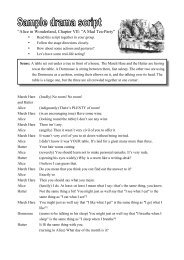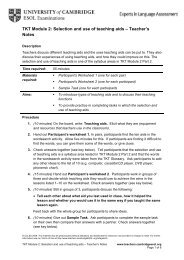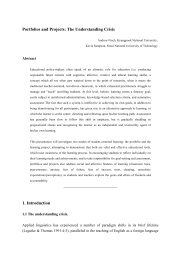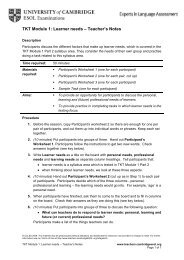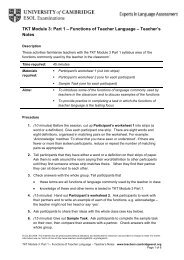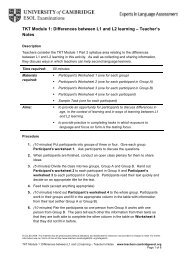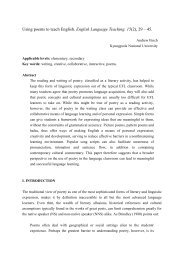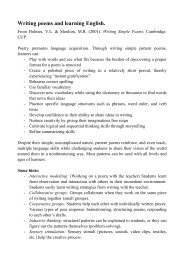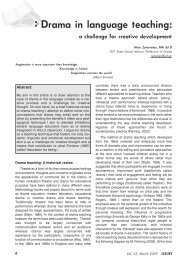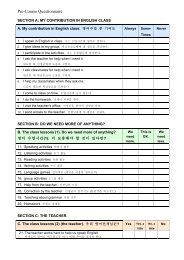teachers should be warned that English immersion does not necessarily make children acquireEnglish more quickly and that premature mainstreaming can have negative effects. Parentalseminars may include lessons on how to read to children to increase comprehension and waysin which to secure reading materials in Korean. T<strong>here</strong> should be communitywide efforts tomake the HL more desirable. T<strong>here</strong> is also the need for more school- and community-basedresearch that shows the benefits of HL maintenance and dissemination of such results to HLcommunities and beyond.5.3. Suggestions for policy-makersKorean HL schools “seem to need substantial community support, especially assistance incurriculum and materials development from university professionals with expertise. A good model,w<strong>here</strong> university professionals and community resources persons actively assist in communitybasedHL schools’ curriculum development and teacher training, seems to be urgently needed.Without such coordinated community support, many HL schools in any language group may remainineffective in providing instruction for HL learners” (Kondo-Brown, 2008, p. 33).Lee & Kim (2008, p. 180) propose an encompassing framework of curriculum development basedon content-based instruction.Although we still lack direct empirical evidence of its total effects, the rationale for content-basedinstruction are drawn from an extensive body of research from multiple fields including secondlanguage acquisition and educational and cognitive psychology (Grabe & Stoller, 1997).Given HL learners’ integrative orientation toward the language and their desire to connect with theirheritage culture, culture would be a natural focus or organizing principle for such curriculum.7. ConclusionThe study of bilingual children is necessarily multifaceted, with a multitude of linguistic,cognitive, social and educational factors contributing to the development of two or morelanguages. Contrary to popular thinking that a bilingual is two monolinguals in one person, abilingual is rarely equally or completely fluent in the two languages. This is because the bilingualspeaker uses his/her two languages for different purposes in different circumstances. Rather thanusing the monolingual as a yardstick against which a bilingual's proficiency in each language ismeasured and judged to fall short, one needs to consider a bilingual as a fully competent speakerwho has developed adequate competences in the two languages for his or her particularcommunicative needs. Related to the idea of considering a bilingual to be a fully competentspeaker is the notion of communicative value of codeswitching. Contrary to popular thinking thatit is an impure, lazy and haphazard mixture of two languages, codeswitching is a valuable conversationaltool for bilingual speakers to communicate their meanings.Children's bilingual utterances and developmental patterns cannot be analyzed in isolation butmust be interpreted in their proper social and cultural context. For example, studies that investigatechildren's successive acquisition of two languages during childhood conclude that immigrantchildren generally lag behind monolingual children in terms of grammatical development in bothlanguages. However, in interpreting these results, one must take into account the larger socialcontext in which the immigrant children are growing up, which systematically denigrates ethniclanguages and cultures. Despite a great deal of research evidence that shows the posi-tive impactof sustained native-language development on the academic achievement of language minoritychildren, much of the educational programs for immigrant children are based on assimilation
ideologies. In most programs, native-language support is only temporary and the underlying goalis acquisition of the majority language.Each child's bilingualism is in a constant state of flux, influenced by a unique combination ofsocializing influences of the family, school and the community. As perhaps the single mostpowerful socializing institution in children's lives, the school serves to integrate language minoritychildren into mainstream society. Children are quick to realize that their native language is notvalued in school and that they must use English to be accepted by their teachers and peers.Children are discouraged from using their native languages and are motivated to speak onlyEnglish, which may also be variably accepted and promoted by their parents and community. Aschildren's English skills are continually improved and refined, their native languages dwindle fromlack of use, eventually resulting in loss. Language loss in immigrant children is not only a loss forimmigrant children but also for their families and the society. It is an absolute tragedy whenparents and children cannot talk to one another due to a lack of a common languageTo promote the development of HLs, it is crucial to understand the processes related to youngchildren's HL acquisition at home. Examination of the language socialisation processes in alanguage minority community reveals the intricate relationships between the specific language andits culture. With this knowledge, we can effectively support HL transmission and maintenance. Forexample, without the knowledge that Koreans highly value society's hierarchical order, wellintendededucators and learners of Korean as HL fail to understand the importance of theappropriate use of complicated honorific systems. Investigating the politeness ideas and practices inKorean-American families, this study argues that the learners of Korean as HL can benefit from anenvironment that requires using various levels of honorifics. Specifically, this study suggests thatteaching hierarchy and honorifics frequently occurs in triadic interactions among a child, a parent,and a grandparent. However, due to the rapid language shift in Korean-American communities(Hing & Lee, 1996; Min, 2000), it is not easy to find the circumstances within which children canobserve and practice honorifics in situations in which people of different statuses converse andinteract (cf. Jo, 2001).This lack of contexts in which various styles and registers of HL can be used is also foundamong other immigrant groups (cf. Valdes, 2001). Consequently, children from language minorityfamilies tend to learn only certain varieties of their HL for "low-level functions and private sp<strong>here</strong>interactions" (Valdes, 2001, p. 46). It is conceivable that this limited context in which to usehonorifics prevents Korean-American children from mastering the use of honorifics. It is likely thatthe children's incorrect use of honorifics is incorrectly interpreted by elders as intentional-impolitebehaviour and even as an act of rejecting their Korean heritage. The negative reactions to children'simperfect use of the Korean language may make them reluctant to use it. Less use of their HL willspeed up the process of language shift. To help develop using Korean in the U.S., Korean-speakingelders should be used to teaching their HL to children in the home, school, and community (cf.Compton, 2001).Studies investigating Ll background factors seem to provide convincing evidence that the EastAsian HL population is highly heterogeneous in terms of their reported or demonstrated proficiencylevels. Previous studies suggest that such heterogeneity in the attained proficiency levels is at leastpartly accounted for by their diverse Ll backgrounds such as age of immigration/arrival, Ll use atearly ages, and parental Ll background. These findings reconfirm the enormous challenge thateducators may face in teaching the heterogeneous HL population. They also indicate the challengethat HL researchers face in ope rationalizing the heritage variable. Future research should continuethe discussion on these issues by examining (a) how teachers can best deal with HL learners whoseproficiency levels are apparently so diverse and (b) to what degrees HL researchers should take thelearner Ll backgrounds into consideration in defining the HL learner variable.



